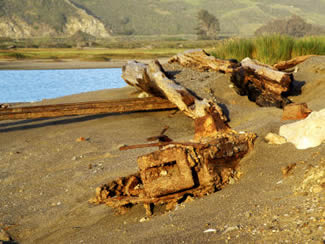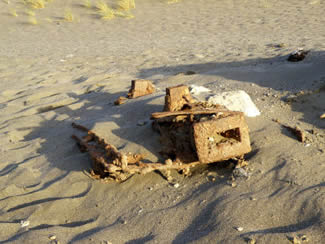– Russell Gaughen
I haven’t walked on Goat Rock State beach for some time and it was a warm late evening just perfect for a few photos and beach walk.
As I left the north parking lot and headed towards the river mouth I was surprised to discover an exposed piece of old railroad equipment. It looked like a small ore or Hopper car. Along with the ore car a whole lot more of existing exposed rail was showing itself. I knew that the ore car had to be part of the small rail line used in the project to build the never finished jetty at the river mouth of the Russian River. The wind has been blowing a lot this year and it had uncovered this abandoned small ore car. The project was to build a jetty out from the mouth of the river and move its entrance to the north a shorter distance to the ocean. This would provide easier passage for barges and boats to cross over the bar.
The Russian River Gravel Company was planning to fill barges with sand and gravel and ship them down to San Francisco for use in the construction of the Golden Gate Bridge and the Bay Bridge. The work at the proposed jetty began in 1929 when the major contractors, Healy & Tibbots, drove pilings and laid rails to block the mouth of the river. What remains of the pilings and rail are visible today.
The two locomotives used to pull the two flat and three dump cars were 4-cylindar Plymouth mine engines. This equipment came from San Francisco having just finished working on the Twin Peaks tunnel. The route of this small rail line was from Goat Island the blasting site to the jetty at the mouth of the river. At one time water surrounded goat Island but when the Jetty project began the face of the rock was blasted and used to create a flat area, now a parking lot, and then for loading the rail cars with material for transport to the jetty.
Goat Island is now named Goat Rock. The day Franklin D. Roosevelt took office, March 5, 1933, the job shut down and didn’t reopen until 1941. That’s when the Basalt Company got the contract and poured cement on the jetty but that is another story.
To me the old dump or hopper car is a treasure and a link with our river history, to others it is just a hunk of rusting metal and wood.
I have used, with permission, information supplied to me from John Schubert the Historian for The Russian River Historical Society. John wrote a column for “The Paper” in 1980 called “Stumptown Stories.” The article “Jenner Jetty lost to the peaceful Pacific” was interesting and very helpful in my search for information concerning this bit of our River History.




